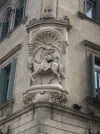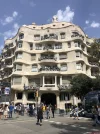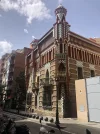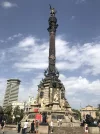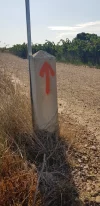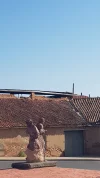Steven Dwyer
Active Member
Day One, Mirador de Colom to Mundet Metro station
Notes on the route: Distance 6 miles, elevation gain 558 ft, elevation loss 102 feet.
https://www.wikiloc.com/hiking-trails/wnd-coast-to-coast-1-41344074
I arrived in Barcelona shortly before noon so I caught the metro to the Drassanes stop and from there a short walk over to the Mirador de Colom, or the Columbus Monument. This towering monument with a Statue of Columbus at the pinnacle sits just across the road from the harbor, so assuming I make it to Santiago and then onwards to Muxia, it will become a cross country journey.
The Camino is unmarked at this beginning so I chose a route that enabled me to see a few of Barcelona’s treasures along the way. From the monument I headed up the tourist congested Las Rambles, turning at a point where I was able to cut through the Plaça Reial, the Royal Square in Barri Gòtic.
Exiting on Carrer de Ferran which took me to the Esglésis Sant Jaume, or the Church of St. James/Santiago. There I was able to purchase a credential in the sacristy for 2€. They are open 10:00 to 14:00 & 17:00 to 20:00. Figured I light a candle while I was there so hit the side altar with The Virgin of Pilar, Saint Nicholas of Bari (Santa Claus) and Saint Expedit, patron saint of speedy cases.
From there I continued ahead to Plaça Sant Jaume, home to the Barcelona City Hall and Palau de la Generaliat. There on the corner of a building was a large wall niche with Santiago. Heading from there up the Carrer del Bisbe you pass under the Pont del Bisbe or bishop’s bridge. This gothic style bridge Is a relatively new addition, dating from 1928. Shortly after the bridge on the left side is the office of the Archbishop of Barcelona. I stopped in and was able to receive a second credential, also 2€. I figure that one credential will not have enough space given the length of the Camino. Both credentials are the official credential of the Cathedral in Santiago.
Just beyond you can turn right into the square for a glimpse of the rather impressive Cathedral. Unfortunately, if you are carrying a backpack, you may not enter. Admission is 7€ if you are not and a sello is available mornings 10:00 to 14:00 in the sacristy. On the opposite side of the square, the rather childlike drawing on the Architect’s College is the work of Pablo Picasso.
Continuing north I headed up Passeig de Gràcia, a major shopping destination street with many high end retailers. As I was passing Casa del Libro, a rather large bookstore I took a chance and popped in and checked there travel section. There I was able to buy their only copy of “El Camino Catalán de Santiago desde Montserrat by Joan Fiol Boada.
Further along Passeig de Gràcia is the Manzana de la Discordia, a block containing houses by 4 of Barcelona’s most important architects. Casa Batlló by Antoni Gaudi is the most noticed, by the Casa Amatller next door is also great. A few blocks north and the corner is dominated by Casa Milà, a monumental work by Gaudi. While there are no arrows marking the way, the intricate tiles of the sidewalk are a less well know design by Gaudi.
Now the road slowly starts to climb as you begin to leave the tourists behind and enter the Barrio Gràcia. if you have worked up an appetite, you will find some restaurants here that a not too pricy and a few with a nice menu del dia. I enjoyed La Tabernacle del Cura, GRAN DE gràcia, 83, 3 course menu with including beverage for 11€.
A short detour will take you past Casa Vicens, an exuberant house which was the first house designed by Gaudi. Just past the Lesseps metro station on the left side of the street is the only Camino marking I encountered. Almost as if my chance I looked down and the was a shell tile, unfortunately facing the wrong direction.
From this point on the road really begins to climb. You are now a distance from the core of the city and you see the green hills of the Parc Natural de la Serra de Collserola, Spain’s largest urban park. On the hills above you can see the Temple of the Sacred Heart of Jesus and the impressive Torre de Collserola, a large communications tower.
From here you are walking alongside the Ronda de Dalt, the ring highway on the north side of Barcelona. You are now in the Vall d’Hebron and you will pass a couple of venues from the 1992 Olympics.
Finally you will reach the Mundet metro station where I chose to stop for the day. I stayed at the Hotel Colors, Carrer de Campoamor, 79, 08031 Barcelona, Spain,. It’s a short distance from Mundet station. My rate was 60€ a night for a single room.
Notes on the route: Distance 6 miles, elevation gain 558 ft, elevation loss 102 feet.
https://www.wikiloc.com/hiking-trails/wnd-coast-to-coast-1-41344074
I arrived in Barcelona shortly before noon so I caught the metro to the Drassanes stop and from there a short walk over to the Mirador de Colom, or the Columbus Monument. This towering monument with a Statue of Columbus at the pinnacle sits just across the road from the harbor, so assuming I make it to Santiago and then onwards to Muxia, it will become a cross country journey.
The Camino is unmarked at this beginning so I chose a route that enabled me to see a few of Barcelona’s treasures along the way. From the monument I headed up the tourist congested Las Rambles, turning at a point where I was able to cut through the Plaça Reial, the Royal Square in Barri Gòtic.
Exiting on Carrer de Ferran which took me to the Esglésis Sant Jaume, or the Church of St. James/Santiago. There I was able to purchase a credential in the sacristy for 2€. They are open 10:00 to 14:00 & 17:00 to 20:00. Figured I light a candle while I was there so hit the side altar with The Virgin of Pilar, Saint Nicholas of Bari (Santa Claus) and Saint Expedit, patron saint of speedy cases.
From there I continued ahead to Plaça Sant Jaume, home to the Barcelona City Hall and Palau de la Generaliat. There on the corner of a building was a large wall niche with Santiago. Heading from there up the Carrer del Bisbe you pass under the Pont del Bisbe or bishop’s bridge. This gothic style bridge Is a relatively new addition, dating from 1928. Shortly after the bridge on the left side is the office of the Archbishop of Barcelona. I stopped in and was able to receive a second credential, also 2€. I figure that one credential will not have enough space given the length of the Camino. Both credentials are the official credential of the Cathedral in Santiago.
Just beyond you can turn right into the square for a glimpse of the rather impressive Cathedral. Unfortunately, if you are carrying a backpack, you may not enter. Admission is 7€ if you are not and a sello is available mornings 10:00 to 14:00 in the sacristy. On the opposite side of the square, the rather childlike drawing on the Architect’s College is the work of Pablo Picasso.
Continuing north I headed up Passeig de Gràcia, a major shopping destination street with many high end retailers. As I was passing Casa del Libro, a rather large bookstore I took a chance and popped in and checked there travel section. There I was able to buy their only copy of “El Camino Catalán de Santiago desde Montserrat by Joan Fiol Boada.
Further along Passeig de Gràcia is the Manzana de la Discordia, a block containing houses by 4 of Barcelona’s most important architects. Casa Batlló by Antoni Gaudi is the most noticed, by the Casa Amatller next door is also great. A few blocks north and the corner is dominated by Casa Milà, a monumental work by Gaudi. While there are no arrows marking the way, the intricate tiles of the sidewalk are a less well know design by Gaudi.
Now the road slowly starts to climb as you begin to leave the tourists behind and enter the Barrio Gràcia. if you have worked up an appetite, you will find some restaurants here that a not too pricy and a few with a nice menu del dia. I enjoyed La Tabernacle del Cura, GRAN DE gràcia, 83, 3 course menu with including beverage for 11€.
A short detour will take you past Casa Vicens, an exuberant house which was the first house designed by Gaudi. Just past the Lesseps metro station on the left side of the street is the only Camino marking I encountered. Almost as if my chance I looked down and the was a shell tile, unfortunately facing the wrong direction.
From this point on the road really begins to climb. You are now a distance from the core of the city and you see the green hills of the Parc Natural de la Serra de Collserola, Spain’s largest urban park. On the hills above you can see the Temple of the Sacred Heart of Jesus and the impressive Torre de Collserola, a large communications tower.
From here you are walking alongside the Ronda de Dalt, the ring highway on the north side of Barcelona. You are now in the Vall d’Hebron and you will pass a couple of venues from the 1992 Olympics.
Finally you will reach the Mundet metro station where I chose to stop for the day. I stayed at the Hotel Colors, Carrer de Campoamor, 79, 08031 Barcelona, Spain,. It’s a short distance from Mundet station. My rate was 60€ a night for a single room.
Attachments
Last edited:



